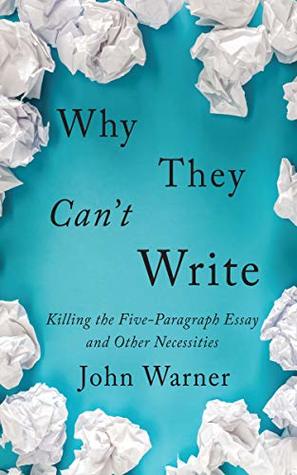More on this book
Community
Kindle Notes & Highlights
by
John Warner
Read between
December 11, 2018 - May 3, 2019
It is our American enthusiasm for believing in solutions that has caused us to lose sight of the real problems. Much of the work to address the achievement gaps among different categories of students is well-meaning, but it has been terribly misguided.
This distresses me. We say education is meant to turn students into critical thinkers, to help them prepare for the demands of a dynamic and changing workplace. School is to make students “college- and career-ready.” We are not doing this when it comes to teaching writing. We are training students to pass standardized assessments, not teaching them how to write.
Doubling down on what’s already failing is not a solution.
Our own writing always makes sense to us because we know what we’re trying to say, and even when our specific choices of expression don’t quite say what we mean, our brains fill in the blanks.
Once we reach a level of proficiency, it is easy to mentally erase the evidence of our own apprenticeships.
In her study of successful writing academics, Helen Sword identified some of the characteristics for writing that writers keep in mind as they work, things like “concision,” “structure,” “voice,” “identity,” “clarity,” “vocabulary,” “agency,” “audience,” and “telling a story.”
The intuition we sometimes credit to expert professionals is not mystical but instead a manifestation of years of observation and practice, a skill in and of itself.
For so long, school has been about performance divorced from learning, so it’s difficult to find value in anything other than an A.
Our willingness to embrace these fads reflects a deep desire to do better by students we know we are failing. By lurching from one fad to another, though, we fail to address the more entrenched underlying conditions that are having a far greater impact on students.
some who prefer to think of school as a proving ground, a test where the worthy triumph and the wanting wither. Those who share this view have the benefit of knowing that school already essentially reflects these values. We call it a meritocracy while failing to recognize the different starting lines afforded those who won the birth lottery—but perhaps one’s parents and social capital are properly viewed as part of one’s “merit.” However, having been born with many of these advantages, I disagree. I have endeavored to become as successful a person as I am able, and yet I am quite certain that
...more
The failing-schools narrative causes us to lurch from fad to fad in an effort to turn the ship around. Trying to fix schools while not paying sufficient attention to the people who populate those schools has only led to a system increasingly antithetical to learning, and even toxic to students’ mental and physical well-being.
the most immediate, straightforward, and cost-effective route to improving student achievement in school is to make sure every child has access to appropriate nutrition and arrives in school having had sufficient rest.
Thirteen million children experience food insecurity—lack of access to nutritious food on a regular basis—and programs such as free lunch and breakfast only partially close these gaps.2 Hungry students are less likely to retain information, they have a more difficult time regulating their moods, they can’t concentrate, and they are more likely to experience stress.
We must recognize that our current schooling systems operate under particular ideologies and those ideologies should be up for questioning. When someone claims they want to “increase student achievement,” we should be asking, Increase how? Achieving what? These are not value-neutral propositions. Different values and ideologies will point toward different solutions.
Somewhere along the line we collectively decided, without actually agreeing, that school is primarily about preparing the future workers of America for their jobs. Maybe it’s rooted in the Reagan Administration’s A Nation at Risk. According to that report our country’s greatness was rooted not in values like freedom, life, and liberty, but our ability to beat the Japanese on standardized tests. Thirty-five years later we have arrived at a place where the kindergarten pageant must be canceled to help make students “college- and career-ready.”10
Taken together, these sentiments suggest the purpose of school is to shape students into something suitable for consumption by corporations. Students being individuals with different backgrounds or hopes or dreams is immaterial. It is a vision of American values that substitutes gainful employment for freedom. In Greene’s words:
This is all alarming because it is such a narrow, cramped, tiny vision of education, a low bar to clear, an unworthy target at which to aim. All the depth and breadth of human experience, all the joy and heartfelt fulfillment to which humans can aspire, all the glorious discovery of one’s best self, all the varied and beautiful experience of being a human in the world—these folks would have us toss all of that away to better turn children into meat widgets who can serve not their own human aspirations and dreams and goals, but the corporate need for drones to fill jobs so that the rich can get
...more
the sentence is not the basic skill or fundamental unit of writing. The idea is.


